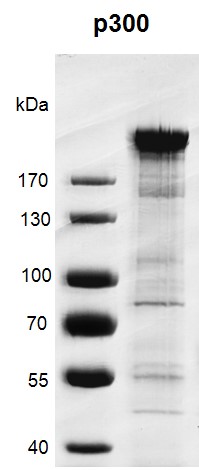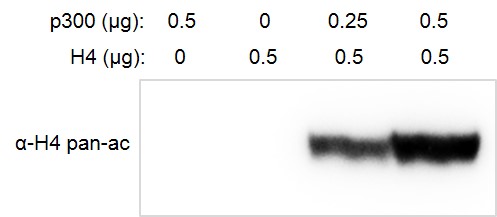Recombinant p300 protein, full length
| Catalog No: 81158 | Format: 10 µg | $580 | Buy |
| Catalog No: 81858 | Format: 100 µg | $4,300 | Buy |
Request a quote for a bulk order Request Quote
Expressed In: Baculovirus Protein Species: Human
Contents
A representative Technical Data Sheet (TDS) is provided here. Please refer to the lot-specific TDS you will receive with your order for the lot-specific buffer contents and protein concentration.
Background
E1A binding protein p300 (EP300) or p300, also known as KAT3B or RSTS2, regulates cellular growth and differentiation and is also important in preventing tumor growth. It binds to transcription factors and functions as a coactivator of transcription. The p300 domain structure that facilitates interaction with transcription factors includes the bromodomain, the nuclear receptor interaction domain (RID), the CREB and MYB interaction domain (KIX), the cysteine/ histidine regions (TAZ1and TAZ2) and the interferon response binding domain (IBiD). Its interaction with adenovirus E1A protein is thought regulate the transforming capacity of E1A. p300 is a transcriptional coactivator with histone acetyl transferase (HAT) activity. It can acetylate all four core histones and regulates transcription via chromatin remodeling. p300 also functions as an acetyltransferase for nonhistone targets. Specifically, p300 acetylates ‘Lys131’ of ALX1 and acts as its coactivator in the presence of CREBBP. p300 is also thought to indirectly increase the transcriptional activity of p53 through acetylation of SIRT2 and subsequent attenuation of its deacetylase function. Additionally, HDAC1 acetylation by p300 leads to HDAC1 inactivation. p300 also acts as a TFAP2A-mediated transcriptional coactivator in the presence of CITED2 and as a coactivator of NEUROD1-dependent transcription of secretin and p21. Additionally, p300 binds to phosphorylated CREB and mediates cAMP gene regulation. It also regulates terminal differentiation of intestinal epithelial cells. In the case of HIV-1 infection, p300 is recruited by the viral protein TAT and regulates TAT’s transactivating activity, and may aid induction of chromatin remodeling of proviral genes.
Application Notes
Recombinant p300 protein is suitable for use in the study of enzyme kinetics, inhibitor screening, and selectivity profiling.
Protein Details
Recombinant p300 protein was expressed in baculovirus expression system as full length protein (accession number NP_001420.2) with an N-terminal FLAG tag. The molecular weight of the protein is 265.4 kDa.
References
The following applications have been published using this protein. Unless noted above, Active Motif may not have validated this product for use in these applications:
Acetylation Assay
View publications that use Active Motif products & services here. Enter the product number(s) to see publications & applications that use this product.
Recombinant p300 protein gel
8% SDS-PAGE Coomassie staining
MW: 265.4 kDa
Purity: >75%
Recombinant p300 protein activity assay
0.5 µg of Histone H4 (Cat. No. 31493) were incubated with 0 µg, 0.25 µg or 0.5 µg of p300 protein, respectively in a 30 µl reaction system including 50 mM Tris pH 8.0, 1 mM TCEP, 0.1 mM EDTA, 50 ng/µl BSA and 20 µM acetyl-CoA for 30 minutes at 30°C.
For each reaction, 7.5 µl product was run on a 12.5% SDS-PAGE gel and detected by Western Blot. p300 only was used as negative control. H4 pan-acetyl antibody (Cat. No. 39243, 1:5000) was used to recognize products.
Storage
Recombinant proteins in solution are temperature sensitive and must be stored at -80°C to prevent degradation. Avoid repeated freeze/thaw cycles and keep on ice when not in storage.
Guarantee
This product is for research use only and is not for use in diagnostic procedures. This product is guaranteed for 6 months from date of arrival.





